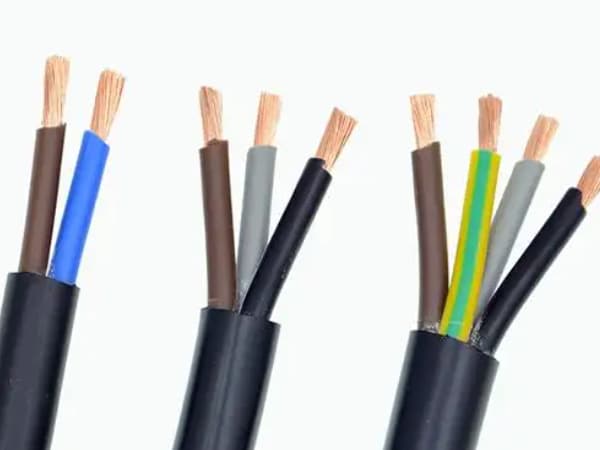Introduction
Electric cable colors come in a variety of colors, each with a specific purpose in electrical systems. Color coding is essential for safety, rapid identification and compliance with international standards. Understanding these colors helps electricians, engineers and users in general to avoid accidents and guarantee adequate connections.
This article explores the meaning of wire colors, Color coding standards in different countries and their application in low electrical systems, medium and high voltage, as well as in domestic wiring.

Why do electrical cables have different colors?
The colors of the cables are used to identify the function of each cable in an electrical system. The main reasons for colored coding include:
- Security: Avoid accidental contact with active cables.
- Standardization: Guarantees uniformity in world electrical installations.
- Ease of maintenance: Allows electricians to identify and solve quickly failures.
- Simplicity in installation: Reduces connection errors and minimizes risks.
International cable colored standards
Different countries follow specific standards for the colored coding of electrical cables. The most used standards are:
- IEC (International Electrotechnical Commission) – IEC 60446/IEC 60445
- National Electric Code (NEC) – EE. UU.
- British norm (BS 7671) – United Kingdom
- Australian and Neozelanda Standard (AS/NZS 3000)
- Indian norm (IS 732)
- Chinese norm (GB 5023.3-2008)
- European Union Standard (HD 308 S2)

Common colors of electrical cables and their meaning
1. Phase cable colors (Assets)
Phase cables transport current from the power supply to the device.
- IEC: Brown
- EE. UU. (NEC): Negro (120V/240V systems)
- United Kingdom (BS 7671): Brown
- Australia/New Zealand: Brown
- India: Rojo
- China: Rojo
- European Union: Brown
2. Colors of neutral cables
Neutral cables complete the circuit and return the current to the source.
- IEC: Azul
- EE. UU. (NEC): White or Gray
- United Kingdom (BS 7671): Azul
- Australia/New Zealand: Azul
- India: Negro
- China: Azul
- European Union: Azul
3. Colors of land cables
Earth cables provide a safe way for the leakage current.
- IEC: Green/yellow
- EE. UU. (NEC): Naked green or copper
- United Kingdom (BS 7671): Green/yellow
- Australia/New Zealand: Green/yellow
- India: Verde
- China: Yellow/green
- European Union: Green/yellow

Cable colors in domestic facilities
For residential electrical systems, Standard colored codes include:
- Phase cable: Brown (UE, United Kingdom, IEC), Negro (EE. His.), Rojo (India, China)
- Neutral cable: Azul (UE, United Kingdom, IEC, China), White or Gray (EE. His.), Negro (India)
- Earth cable: Green/yellow (UE, United Kingdom, IEC, China), Naked green or copper (EE. His.), Verde (India)
Correctly identifying these cables is essential to avoid installation errors and possible hazards.
Cable color variations in different electrical systems
A. Color coding in low voltage cables (BT)
Low voltage cables (hasta 1000V) They are used in homes, commercial buildings and small industries.
- Single -phase systems: Brown (Phase), Azul (Neutral), Green/yellow (Tierra)
- Three -phase systems: Brown (L1), Negro (L2), Gris (L3)
B. Color coding in medium voltage cables (MT)
Medium voltage cables (1000V a 35kV) They are used in the distribution of energy in industrial and commercial applications.
- Common phase colors: Rojo, Yellow, Azul (Ancient systems)
- Modern standards: Brown (L1), Negro (L2), Gris (L3)
- Neutral: Blue or white
- Tierra: Green/yellow
C. Color coding in high voltage cables (AT)
High voltage cables (More than 35kv) They are used for transmission lines and substations.
- Phase conductors: Rojo, Yellow, Azul (Ancient systems)
- Current standards: Brown, Negro, Gris
- Tierra: Green/yellow

Importance of following cable colors standards
Not respecting colored coding can cause:
- Electrical risks such as downloads and fires.
- Difficulty in problem solving and maintenance.
- Failure to comply with electrical regulations, which can lead to sanctions and security problems.
Special cable cable colors and its uses
In addition to standard cables, Some colors have specific applications:
- Orange: Isolated circuits, as support energy.
- Yellow: Control circuits in industrial environments.
- Purple/Violet: Connections in fire alarm systems.
- Rosa: Some types of telecommunications wiring.
Conclusion
Understand the wire colors electric is essential for electricians, engineers and any person involved in electrical installations. Different countries apply specific colored codes to guarantee security, consistency and ease of maintenance. Domestic wiring systems, Low, medium and high voltage have well -defined standards to avoid errors and risks. Follow these regulations minimizes hazards, facilitates problem solving and ensures compliance with electrical regulations.
